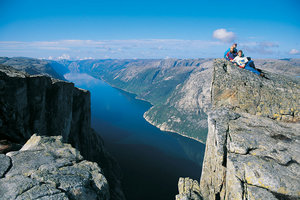Fjord
|
|
A fjord (IPA or ; sometimes written fiord, notably in New Zealand English) is a glacially overdeepened valley, usually narrow and steep-sided, extending below sea level and filled with salt water.
| Contents |
Characteristics
Fjords are found in locations where current or past glaciation extended below current sea level. A fjord is formed when a glacier retreats, after carving its typical U-shaped valley, and the sea fills the resulting valley floor. This forms a narrow, steep sided inlet (sometimes as deep as 1300m) connected to the sea. The terminal moraine pushed down the valley by the glacier is left underwater at the fjord's entrance, causing the water at the neck of the fjord to be shallower than the main body of the fjord behind it.
This shallow threshold and the protection afforded by the valley's sides generally means that fjords are excellent natural harbours. Consequently fjords often provide a home-port to fishing fleets, and in industrialised locations have come to be used for fish farming and shipbuilding.
As late as 2000, some of the world's largest coral reefs were discovered along the bottoms of the Norwegian fjords. These reefs were found in fjords all the way from the north of Norway to the south. The marine life on the reefs is believed to be one of the most important reasons why the Norwegian coastline is such a generous fishing ground. Since this discovery is fairly new, little research has yet been done. So far, only the deep sea diver who discovered the first reef at 60 meters has visited it, and even he has only been down three times. The reefs are host to thousands of lifeforms such as plankton, coral, anemonies, fish, several species of sharks, and many more one would expect to find on a reef. However most are specially adapted to life under the greater pressure of the water column above it, and the total darkness of the deep sea.
New Zealand's fiords are also host to deep sea corals, but a surface layer of dark fresh water allows these corals to grow in much shallower water than usual. An underwater observatory in Milford Sound allows tourists to view them without diving.
Locations
Gros_morne_fiord.jpg
Fjords are found all along the coast of:
- Norway
- Iceland
- Greenland
- Labrador
- Montenegro
- the west coast of Scotland (where called "sea lochs")
- the southwest corner of New Zealand (see Fiordland)
- on the west coast of Newfoundland in Gros Morne National Park
- British Columbia down to Puget Sound
- the south and west coasts of Alaska
- southern Chile
- on the coast of the Baltic Sea in Germany
- in parts of Antarctica, particularly the Antarctic Peninsula
- various Arctic and Sub-antarctic islands
The longest fjords in the world are:
- Scoresby Sund on Greenland, (350 km)
- Sognefjord in Norway (203 km)
- Hardangerfjord in Norway (179 km)
The long fjord-like bays of the New England coast are sometimes referred to as "fiards". The only true fjord in New England is Somes Sound in Maine. It is located on Mount Desert Island in Acadia National Park.
The Lim bay in Istria, Croatia, is sometimes called "Lim fjord" although it is not actually a fjord created by glaciation but instead an estuary created by the erosive forces of the river Pazinčica.
Linguistic notes

The word fjord comes from the Scandinavian languages, and is cognate to firth. In Scandinavia, fjord is used for narrow inlets in Norway, Denmark and western Sweden, whereas the name fjärd is used in a synonymous manner for narrow inlets on Sweden's Baltic Sea coast, and in most Swedish lakes. This latter term is also used for bodies of water off the coast of Finland where Swedish is spoken. Note that the uses for the words fjord and especially for the eastern form fjärd are more general in the Scandinavian languages than in English. Fjord in the English sense is taken from a type of fjord found in Norway and in parts of Sweden.
Fjords in literature and popular culture
- Slartibartfast, a character in Douglas Adams's The Hitchhiker's Guide to the Galaxy, is noted for having crafted the fjords in Norway.
- In Monty Python's famous Dead Parrot sketch, Michael Palin asserts that John Cleese's deceased Norwegian Blue parrot is, not dead, but rather "pining for the fjords".
- Pinky, of Pinky and the Brain fame was known to, on occasion, exclaim "FJORD!" for no apparent reason.
See also
External links
- Use of whales to probe Arctic fjord's secrets (http://news.bbc.co.uk/1/hi/sci/tech/2683797.stm)
- Pictures and info about Norwegian fjords (http://www.fjords.com)
- Fiordland's Marine Environment (and corals) (http://www.doc.govt.nz/Conservation/Marine-and-Coastal/Marine-Reserves/025~Fiordlands-Marine-Reserves/index.asp#Marine-Environment)
- Gallery of corals and associated marine life (http://www.milforddeep.co.nz/gallery.htm)ca:Fiord
de:Fjord es:Fiordo eo:fjordo fa:آبدره fr:Fjord id:Fyord he:פיורד nl:Fjord ja:フィヨルド nb:Fjord nn:Fjord pl:Fiord pt:Fiorde ru:Фьорд fi:Vuono sv:Fjord

